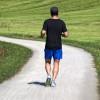BACKGROUND:In order to implement running to promote physical activity, it is essential to quantify the extent to which running improves health.
OBJECTIVE:The aim was to summarise the literature on the effects of endurance running on biomedical indices of health in physically inactive adults.
DATA SOURCES:Electronic searches were conducted in October 2014 on PubMed, Embase, CINAHL, SPORTDiscus, PEDro, the Cochrane Library and LILACS, with no limits of date and language of publication.
STUDY SELECTION:Randomised controlled trials (with a minimum of 8 weeks of running training) that included physically inactive but healthy adults (18-65 years) were selected. The studies needed to compare intervention (i.e. endurance running) and control (i.e., no intervention) groups.
STUDY APPRAISAL AND SYNTHESIS METHODS:Two authors evaluated study eligibility, extracted data, and assessed risk of bias; a third author resolved any uncertainties. Random-effects meta-analyses were performed to summarise the estimates for length of training and sex. A dose-response analysis was performed with random-effects meta-regression in order to investigate the relationship between running characteristics and effect sizes.
RESULTS:After screening 22,380 records, 49 articles were included, of which 35 were used to combine data on ten biomedical indices of health. On average the running programs were composed of 3.7± 0.9 sessions/week, 2.3 ± 1.0 h/week, 14.4 ± 5.4 km/week, at 60-90% of the maximum heart rate, and lasted 21.5 ± 16.8 weeks. After 1 year of training, running was effective in reducing body mass by 3.3 kg [95% confidence interval (CI) 4.1-2.5], body fat by 2.7% (95% CI 5.1-0.2), resting heart rate by 6.7 min(-1) (95% CI 10.3-3.0) and triglycerides by 16.9 mg dl(-1) (95% CI 28.1-5.6). Also, running significantly increased maximal oxygen uptake (VO2max) by 7.1 ml min(-1) kg(-1) (95% CI 5.0-9.1) and high-density lipoprotein (HDL) cholesterol by 3.3 mg dl(-1) (95% CI 1.2-5.4). No significanteffect was found for lean body mass, body mass index, total cholesterol and low-density lipoprotein cholesterol after 1 year of training. In the dose-response analysis, larger effect sizes were found for longer length of training.
LIMITATIONS:It was only possible to combine the data of ten out the 161 outcome measures identified. Lack of information on training characteristics precluded a multivariate model in the dose-response analysis.
CONCLUSIONS:Endurance running was effective in providing substantial beneficial effects on body mass, body fat, resting heart rate, VO2max, triglycerides and HDL cholesterol in physically inactive adults. The longer the length of training, the larger the achieved health benefits. Clinicians and health authorities can use this information to advise individuals to run, and to support policies towards investing in running programs.
 Running is a method of terrestrial locomotion allowing humans and other animals to move rapidly on foot. Running is a type of gait characterized by an aerial phase in which all feet are above the ground (though there are exceptions). This is in contrast to walking, where one foot is always in contact with the ground, the legs are kept mostly straight and the center of gravity vaults over the stance leg or legs in an inverted pendulum fashion. A characteristic feature of a running body from the viewpoint of spring-mass mechanics is that changes in kinetic and potential energy within a stride occur simultaneously, with energy storage accomplished by springy tendons and passive muscle elasticity. The term running can refer to any of a variety of speeds ranging from jogging to sprinting.
Running is a method of terrestrial locomotion allowing humans and other animals to move rapidly on foot. Running is a type of gait characterized by an aerial phase in which all feet are above the ground (though there are exceptions). This is in contrast to walking, where one foot is always in contact with the ground, the legs are kept mostly straight and the center of gravity vaults over the stance leg or legs in an inverted pendulum fashion. A characteristic feature of a running body from the viewpoint of spring-mass mechanics is that changes in kinetic and potential energy within a stride occur simultaneously, with energy storage accomplished by springy tendons and passive muscle elasticity. The term running can refer to any of a variety of speeds ranging from jogging to sprinting.